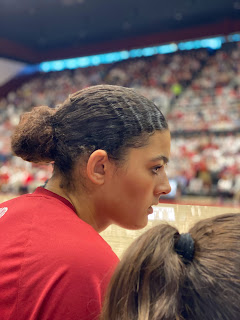Coming Up Short In Utah
It is a testament to how "classy" Stanford's coach is that, in commenting on the Cardinal's loss at Utah, Tara simply said that Utah was the better team in the game. She didn't point to the insane schedule the CARD had endured -- 3 ranked teams in six days (4 in eight), two plane trips (including one with a multiple hour delay), and a 43-hour turnaround after winning a double overtime game -- 43 hours that included that multi-hour travel delay. If the CARD had pulled off a win against a highly motivated Utah team seeking a share of the Pac-12 title for the first time on the Utah home court, it would be time to start passing out Superhero capes. Even with all that adversity, the CARD kept it close, trailing by only one point with less than two-and-a-half minutes to go in the 4th.
The effect of fatigue on Stanford players was evident -- usually sure handed players had difficulty holding on to the ball, great shooters missed layups, and players moved a step too slow on defense. Utah won the turnover battle, turning the ball over only 10 times while the CARD turned the ball over 21 times! But, in the final analysis, Utah won the game at the free-throw line, hitting 26 of their 33 free-throws while the CARD hit only 11 of 17. The huge disparity in free-throws taken belies the fact that Stanford was only called for five more fouls (28 to 23). To admittedly partisan eyes, it seemed that in some cases Utah players were ruled "in the act of shooting" when they were merely "on their way to the basket," while Stanford players getting knocked down while shooting didn't get an "and-one."
Of course, Stanford players and coaches won't make any excuses for the loss. They will simply learn what there is to be learned (mostly get a good night's sleep before a big game) and use it as motivation should they meet Utah in the Pac-12 Tournament Finals as they will if seeding holds. However, we certainly hope that the NCAA Committee takes that adversity into account. Winning the Pac-12 Tournament would resolve that issue.
Bright Spots
Perhaps the brightest spot is the fight that Stanford demonstrated. After the gauntlet Stanford had faced, just showing up and jumping out to a 9-0 lead and battling back time and again -- pulling to within one, two-, or three-points numerous times after going down by more ten points -- is impressive. This team has heart!
Another bright spot was the continued prowess of Cameron Brink at the free-throw line. She only missed one free-throw for the ENTIRE MONTH OF FEBRUARY. Cam hit 8 of 8 against Utah, 15 of 15 against UCLA, 4 of 4 against Arizona, 5 of 6 against Arizona State, 4 of 4 against Washington, and 2 of 2 against Washington State (she did not go to the line against Colorado). Impressive for a player whose FT average was in the 60% range in her first two years! It was also a positive to see Hannah Jump score 24 points, including 6 threes. Those threes may put her back into the top 5 nationally. (Hannah is currently 7th nationally.)
This game, coming at the end of a grueling stretch, also gave Stanford a chance to employ its depth. Many of the players who have had fewer minutes during the Pac-12 season got a chance to show what they can do, and they all contributed. Stanford's bench contributed 24 points compared to Utah's 15.
Questions
1. What will be the first upset of the Pac-12 Tournament?
Reflecting the conference's strength, the Pac-12 tournament regularly sees upsets. With the conclusion of the final regular season games, the tournament bracket is set -- but we can expect that the seeding will not hold perfectly. Stanford is the #1 seed while Co-Champion Utah is the #2 seed. Stanford's first game, scheduled for 2:30 on Thursday, will be against the winner of Wednesday's game between Washington and Oregon. If that is Washington it would give the CARD the chance to avenge one of its three Pac-12 losses. Who knows what comes next.


